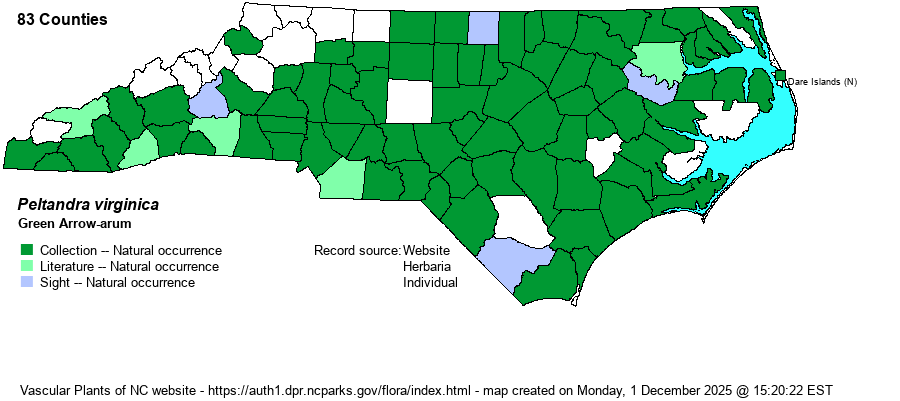| Author | (L.) Schott | |
| Distribution | Throughout the Coastal Plain and essentially throughout the Piedmont; of spotty occurrence in the Mountains and far western Piedmont, but could occur in every county.
This is an Eastern species ranging north to southern Canada and south to southern FL and eastern TX. It is mostly absent in montane regions and bizarrely so across much of the center of this large range. | |
| Abundance | Generally frequent to common in most of the Coastal Plain and eastern Piedmont. Uncommon in the western portions of the Piedmont and the southern Mountains, but rare in the northern Mountains. | |
| Habitat | This is an aquatic/wetland species with a very wide range of marshy habitats. It occurs in fresh marshes, beaver ponds and other pools and pond margins, openings in swamps and bottomlands, and in bogs. It shows little affinity toward acidic/peaty soils that P. sagittifolia does. |
| Phenology | Blooms in May and June, and fruits shortly after flowering. The berrylike fruits are green to brown (vs. red in P. sagittifolia. | |
| Identification | This is one of several marsh species with large triangular leaves and sagittate (arrowhead-shaped) bases. Away from coastal areas, such a plant is more than likely either this species or Broadleaf Arrowhead (Sagittaria latifolia). This species has leaves to about 18 long long, of which the petiole is the lower two-thirds of the leaf. The blades of the several leaves are about 6 inches long and about half as wide, being tapered to the apex and with a rather arrowhead shape to the base. The leaves of Peltandra tend to have straight veins, whereas some veins are strongly curved on the leaf of a Sagittaria. This species has a flowering stalk that extends out of the water to about 1.5 feet high, with the top 3-5 inches being a light green, "rolled" spathe that barely is opened enough to see the spadix within it. Thus, at much distance one is not clearly able to see the inflorescence. Most biologists run into this plant often in their work, especially around pond margins and marsh edges. | |
| Taxonomic Comments | None
| |
| Other Common Name(s) | Arrow-arum is often used for the genus as a whole, as there are just two species in the genus; Tuckahoe (a poor, idiosyncratic name), Bog Arum | |
| State Rank | S5 | |
| Global Rank | G5 | |
| State Status | | |
| US Status | | |
| USACE-agcp | OBL link |
| USACE-emp | OBL link |

